try this approach:
compute the homography from 4 point correspondences, giving you all information to transform between image plane and ground plane coordinates.
limitation of this approach is that it assumes a uniformly parameterized image plane (pinhole camera), so lens distortion will give you errors as seen in my example. if you are able to remove lens distortion effects, you'll go very well with this approach i guess.
In addition you will get some error of giving slightly wrong pixel coordinates as your correspondences, you can get more stable values if you provide more correspondences.
Using this input image

I've read the 4 corners of one chess field from an image manipulation software, which will correspond to the fact that you know 4 points in your image. I've chosen those points (marked green):

now I've done two things: first transforming chessboard pattern coordinates to image (0,0) , (0,1) etc this gives a good visual impression of mapping quality. second I transform from image to world. reading the leftmost corner position in image location (87,291) which corresponds to (0,0) in chessboard coordinates. if i transform that pixel location you would expect (0,0) as a result.
cv::Point2f transformPoint(cv::Point2f current, cv::Mat transformation)
{
cv::Point2f transformedPoint;
transformedPoint.x = current.x * transformation.at<double>(0,0) + current.y * transformation.at<double>(0,1) + transformation.at<double>(0,2);
transformedPoint.y = current.x * transformation.at<double>(1,0) + current.y * transformation.at<double>(1,1) + transformation.at<double>(1,2);
float z = current.x * transformation.at<double>(2,0) + current.y * transformation.at<double>(2,1) + transformation.at<double>(2,2);
transformedPoint.x /= z;
transformedPoint.y /= z;
return transformedPoint;
}
int main()
{
// image from http://d20uzhn5szfhj2.cloudfront.net/media/catalog/product/cache/1/image/9df78eab33525d08d6e5fb8d27136e95/5/2/52440-chess-board.jpg
cv::Mat chessboard = cv::imread("../inputData/52440-chess-board.jpg");
// known input:
// image locations / read pixel values
// 478,358
// 570, 325
// 615,382
// 522,417
std::vector<cv::Point2f> imageLocs;
imageLocs.push_back(cv::Point2f(478,358));
imageLocs.push_back(cv::Point2f(570, 325));
imageLocs.push_back(cv::Point2f(615,382));
imageLocs.push_back(cv::Point2f(522,417));
for(unsigned int i=0; i<imageLocs.size(); ++i)
{
cv::circle(chessboard, imageLocs[i], 5, cv::Scalar(0,0,255));
}
cv::imwrite("../outputData/chessboard_4points.png", chessboard);
// known input: this is one field of the chessboard. you could enter any (corresponding) real world coordinates of the ground plane here.
// world location:
// 3,3
// 3,4
// 4,4
// 4,3
std::vector<cv::Point2f> worldLocs;
worldLocs.push_back(cv::Point2f(3,3));
worldLocs.push_back(cv::Point2f(3,4));
worldLocs.push_back(cv::Point2f(4,4));
worldLocs.push_back(cv::Point2f(4,3));
// for exactly 4 correspondences. for more you can use cv::findHomography
// this is the transformation from image coordinates to world coordinates:
cv::Mat image2World = cv::getPerspectiveTransform(imageLocs, worldLocs);
// the inverse is the transformation from world to image.
cv::Mat world2Image = image2World.inv();
// create all known locations of the chessboard (0,0) (0,1) etc we will transform them and test how good the transformation is.
std::vector<cv::Point2f> worldLocations;
for(unsigned int i=0; i<9; ++i)
for(unsigned int j=0; j<9; ++j)
{
worldLocations.push_back(cv::Point2f(i,j));
}
std::vector<cv::Point2f> imageLocations;
for(unsigned int i=0; i<worldLocations.size(); ++i)
{
// transform the point
cv::Point2f tpoint = transformPoint(worldLocations[i], world2Image);
// draw the transformed point
cv::circle(chessboard, tpoint, 5, cv::Scalar(255,255,0));
}
// now test the other way: image => world
cv::Point2f imageOrigin = cv::Point2f(87,291);
// draw it to show which origin i mean
cv::circle(chessboard, imageOrigin, 10, cv::Scalar(255,255,255));
// transform point and print result. expected result is "(0,0)"
std::cout << transformPoint(imageOrigin, image2World) << std::endl;
cv::imshow("chessboard", chessboard);
cv::imwrite("../outputData/chessboard.png", chessboard);
cv::waitKey(-1);
}
the resulting image is:

as you can see there is some big amount of error in the data. as I said it's because of slightly wrong pixel coordinates given as correspondences (and within a small area!) and because of lens distortion preventing the ground plane to appear as a real plane on the image.
results of transforming (87,291) to world coordinates are:
[0.174595, 0.144853]
expected/perfect result would've been [0,0]
hope this helps.


